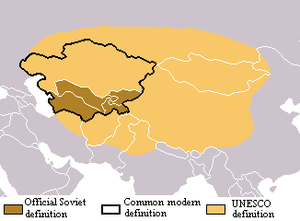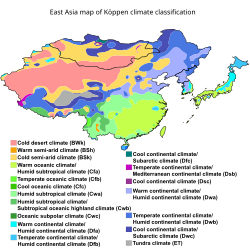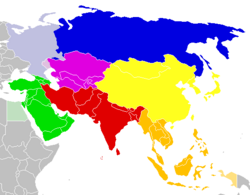East Asia is the eastern region of Asia, which is defined in both geographical and ethno-cultural terms. The modern states of East Asia include China, Japan, Mongolia, North Korea, South Korea, and Taiwan. China, North Korea, South Korea and Taiwan are all unrecognized by at least one other East Asian state due to severe ongoing political tensions in the region, specifically the division of Korea and the political status of Taiwan. Hong Kong and Macau, two small coastal quasi-dependent territories located in the south of China, are officially highly autonomous but are under de jure Chinese sovereignty. Siberia borders East Asia’s north, Southeast Asia the south, South Asia the southwest and Central Asia the west. To the east is the Pacific Ocean and to the southeast is Micronesia (a Pacific Ocean island group, classified as part of Oceania).
East Asia, especially Chinese civilization, is regarded as one of the earliest cradles of civilization. Other ancient civilizations in East Asia that still exist as independent countries in the present day include the Japanese, Korean and Mongolian civilizations. Various other civilizations existed in East Asia in the past but have since been absorbed into neighbouring civilizations in the present day, such as Tibet, Baiyue, Manchuria and Ryukyu, among many others. Taiwan has a relatively young history in the region after the prehistoric era; originally, it was a major site of Austronesian civilization prior to colonization by European colonial powers and China from the 17th century onward. For thousands of years, China was the leading civilization in the region, exerting influence on its neighbors. Historically, societies in East Asia have fallen within the Chinese sphere of influence, and East Asian vocabulary and scripts are often derived from Classical Chinese and Chinese script. The Chinese calendar serves as the root from which many other East Asian calendars are derived. Major religions in East Asia include Buddhism (mostly Mahayana), Confucianism and Neo-Confucianism, Taoism, Ancestral worship, and Chinese folk religion in Mainland China, Hong Kong, Macau and Taiwan, Shintoism in Japan, and Christianity, and Sindoism in Korea. Tengerism and Tibetan Buddhism are prevalent among Mongols and Tibetans while other religions such as Shamanism are widespread among the indigenous populations of northeastern China such as the Manchus. Major languages in East Asia include Mandarin Chinese, Japanese, and Korean. Major ethnic groups of East Asia include the Han (mainland China, Hong Kong, Macau, Taiwan), Yamato (Japan) and Koreans (North Korea, South Korea). Mongols, although not as populous as the previous three ethnic groups, constitute the majority of Mongolia’s population. There are 76 officially-recognized minority or indigenous ethnic groups in East Asia; 55 native to mainland China (including Hui, Manchus, Chinese Mongols, Tibetans, Uyghurs and Zhuang in the frontier regions), 16 native to the island of Taiwan (collectively known as Taiwanese indigenous peoples), one native to the major Japanese island of Hokkaido (the Ainu) and four native to Mongolia (Turkic peoples). Ryukyuan people are an unrecognised ethnic group indigenous to the Ryukyu Islands in southern Japan, which stretch from Kyushu Island (Japan) to Taiwan. There are also several unrecognised indigenous ethnic groups in mainland China and Taiwan.
East Asians comprise around 1.7 billion people, making up about 38% of the population in Continental Asia and 20.5% of the global population. The region is home to major world metropolises such as Beijing, Hong Kong, Seoul, Shanghai, Taipei, and Tokyo. Although the coastal and riparian areas of the region form one of the world’s most populated places, the population in Mongolia and Western China, both landlocked areas, is very sparsely distributed, with Mongolia having the lowest population density of a sovereign state. The overall population density of the region is 133 inhabitants per square kilometre (340/sq mi), about three times the world average of 45/km2 (120/sq mi).
East Asia has some of the world’s largest and most prosperous economies: Mainland China, Japan, South Korea, Taiwan, Hong Kong, and Macau.
History
China was the first region settled in East Asia and was undoubtedly the core of East Asian civilization from where other parts of East Asia were formed. The various other regions in East Asia were selective in the Chinese influences they adopted into their local customs. Historian Ping-ti Ho famously labeled Chinese civilization as the “Cradle of Eastern Civilization”, in parallel with the “Cradle of Western Civilization” along the Fertile Crescent encompassing Mesopotamia and Ancient Egypt.
Chinese civilization existed for about 1500 years before other East Asian civilizations emerged into history, Imperial China would exert much of its cultural, economic, technological, and political muscle onto its neighbors. Succeeding Chinese dynasties exerted enormous influence across East Asia culturally, economically, politically and militarily for over two millennia. The Imperial Chinese tributary system shaped much of East Asia’s history for over two millennia due to Imperial China’s economic and cultural influence over the region, and thus played a huge role in the history of East Asia in particular. Imperial China’s cultural preeminence not only led the country to become East Asia’s first literate nation in the entire region, it also supplied Japan and Korea with Chinese loanwords and linguistic influences rooted in their writing systems.
Under Emperor Wu of Han, the Han dynasty made China the regional power in East Asia, projecting much of its imperial power on its neighbors. Han China hosted the largest unified population in East Asia, the most literate and urbanized as well as being the most economically developed, as well as the most technologically and culturally advanced civilization in the region at the time. Cultural and religious interaction between the Chinese and other regional East Asian dynasties and kingdoms occurred. China’s impact and influence on Korea began with the Han dynasty’s northeastern expansion in 108 BC when the Han Chinese conquered the northern part of the Korean peninsula and established a province called Lelang. Chinese influence would soon take root in Korea through the inclusion of the Chinese writing system, monetary system, rice culture, and Confucian political institutions. Jomon society in ancient Japan incorporated wet-rice cultivation and metallurgy through its contact with Korea. Starting from the fourth century AD, Japan incorporated the Chinese writing system which evolved into Kanji by the fifth century AD and has become a significant part of the Japanese writing system. Utilizing the Chinese writing system allowed the Japanese to conduct their daily activities, maintain historical records and give form to various ideas, thoughts, and philosophies. During the Tang dynasty, China exerted its greatest influence on East Asia as various aspects of Chinese culture spread to Japan and Korea. As full-fledged medieval East Asian states were established, Korea by the fourth century AD and Japan by the seventh century AD, Japan and Korea actively began to incorporate Chinese influences such as Confucianism, the use of written Han characters, Chinese style architecture, state institutions, political philosophies, religion, urban planning, and various scientific and technological methods into their culture and society through direct contacts with Tang China and succeeding Chinese dynasties. Drawing inspiration from the Tang political system, Prince Naka no oe launched the Taika Reform in 645 AD where he radically transformed Japan’s political bureaucracy into a more centralized bureaucratic empire. The Japanese also adopted Mahayana Buddhism, Chinese style architecture, and the imperial court’s rituals and ceremonies, including the orchestral music and state dances had Tang influences. Written Chinese gained prestige and aspects of Tang culture such as poetry, calligraphy, and landscape painting became widespread. During the Nara period, Japan began to aggressively import Chinese culture and styles of government which included Confucian protocol that served as a foundation for Japanese culture as well as political and social philosophy. The Japanese also created laws adopted from the Chinese legal system that was used to govern in addition to the kimono, which was inspired from the Chinese robe (hanfu) during the eighth century AD. For many centuries, most notably from the 7th to the 14th centuries, China stood as East Asia’s most advanced civilization and foremost military and economic power exerting its influence as the transmission of advanced Chinese cultural practices and ways of thinking greatly shaped the region up until the nineteenth century.
As East Asia’s connections with Europe and the Western world strengthened during the late nineteenth century, China’s power began to decline. By the mid-nineteenth century, the weakening Qing dynasty became fraught with political corruption, obstacles and stagnation that was incapable of rejuvenating itself as a world power in contrast to the industrializing Imperial European colonial powers and a rapidly modernizing Japan. The U.S. Commodore Matthew C. Perry would open Japan to Western ways, and the country would expand in earnest after the 1860s. Around the same time, Japan with its rush to modernity transformed itself from an isolated feudal samurai state into East Asia’s first industrialized nation in the modern era. The modern and militarily powerful Japan would galvanize its position in the Orient as East Asia’s greatest power with a global mission poised to advance to lead the entire world. By the early 1900s, the Japanese empire succeeded in asserting itself as East Asia’s most dominant power. With its newly found international status, Japan would begin to challenge the European colonial powers and inextricably took on a more active geopolitical position in East Asia and world affairs at large. Flexing its nascent political and military might, Japan soundly defeated the stagnant Qing dynasty during the First Sino-Japanese War as well as vanquishing imperial rival Russia in 1905; the first major military victory in the modern era of an East Asian power over a European one. Its hegemony was the heart of an empire that would include Taiwan and Korea. During World War II, Japanese expansionism with its imperialist aspirations through the Greater East Asia Co-Prosperity Sphere would incorporate Korea, Taiwan, much of eastern China and Manchuria, Hong Kong, and Southeast Asia under its control establishing itself as a maritime colonial power in East Asia. After a century of exploitation by the European and Japanese colonialists, post-colonial East Asia saw the defeat and occupation of Japan by the victorious Allies as well as the division of China and Korea during the Cold War. The Korean peninsula became independent but then it was divided into two rival states, while Taiwan became the main territory of de facto state Republic of China after the latter lost Mainland China to the People’s Republic of China in the Chinese Civil War. During the latter half of the twentieth century, the region would see the post war economic miracle of Japan, which ushered in three decades of unprecedented growth, only to experience an economic slowdown during the 1990s, but nonetheless Japan continues to remain a global economic power. East Asia would also see the economic rise of South Korea and Taiwan, and the integration of Mainland China into the global economy through its entry in the World Trade Organization while enhancing its emerging international status as a potential world power. Although there have been no wars in East Asia for decades, the stability of the region remains fragile because of North Korea’s nuclear program.
Definitions

Three sets of possible boundaries for the Central Asia region that overlap with conceptions of East Asia
In common usage, the term “East Asia” typically refers to a region including Greater China, Japan, and Korea.
China, Japan, and Korea represent the three core countries and civilizations of traditional East Asia – as they once shared a common written language, culture, as well as sharing Confucian philosophical tenets and the Confucian societal value system once instituted by Imperial China. Other usages define Mainland China, Hong Kong, Macau, Japan, North Korea, South Korea and Taiwan as countries that constitute East Asia based on their geographic proximity as well as historical and modern cultural and economic ties, particularly with Japan and Korea having strong cultural influences that originated from China. Some scholars include Vietnam as part of East Asia as it has been considered part of the greater Chinese sphere of influence. Though Confucianism continues to play an important role in Vietnamese culture, Chinese characters are no longer used in its written language and many scholarly organizations classify Vietnam as a Southeast Asian country. Mongolia is geographically north of Mainland China yet Confucianism and the Chinese writing system and culture had limited impact on Mongolian society. Thus, Mongolia is sometimes grouped with Central Asian countries such as Turkmenistan, Kyrgyzstan, and Kazakhstan. Xinjiang (East Turkestan) and Tibet are sometimes seen as part of Central Asia.
Broader and looser definitions by international organizations such as the World Bank refer to the “three major Northeast Asian economies, i.e. Mainland China, Japan, and South Korea”, as well as Mongolia, North Korea, the Russian Far East and Siberia. The Council on Foreign Relations includes the Russia Far East, Mongolia, and Nepal. The World Bank also acknowledges the roles of sub-national or de facto states, such as Hong Kong, Macau, and Taiwan. The Economic Research Institute for Northeast Asia defines the region as “China, Japan, the Koreas, Nepal, Mongolia, and eastern regions of the Russian Federation”.

The countries of East Asia also form the core of Northeast Asia, which itself is a broader region.

East Asia map of Köppen climate classification.

UNSD geoscheme for Asia based on statistic convenience rather than implying any assumption regarding political or other affiliation of countries or territories:
The UNSD definition of East Asia is based on statistical convenience, but also other common definitions of East Asia contain the Mainland China, Hong Kong, Macau, Mongolia, North Korea, South Korea, Taiwan and Japan.
Alternative definitions
In business and economics, “East Asia” is sometimes used to refer to a wide geographical area covering ten Southeast Asian countries in ASEAN, Greater China, Japan and Korea. However, in this context, the term “Far East” is used by the Europeans to cover ASEAN countries and the countries in East Asia. However, being a Eurocentric term, Far East describes the region’s geographical position in relation to Europe rather than its location within Asia. Alternatively, the term “Asia Pacific Region” is often used in describing East Asia, Southeast Asia as well as Oceania.
Observers preferring a broader definition of “East Asia” often use the term Northeast Asia to refer to China, the Korean Peninsula, and Japan, with Southeast Asia covering the ten ASEAN countries. This usage, which is seen in economic and diplomatic discussions, is at odds with the historical meanings of both “East Asia” and “Northeast Asia”. The Council on Foreign Relations of the United States defines Northeast Asia as Japan and Korea.
